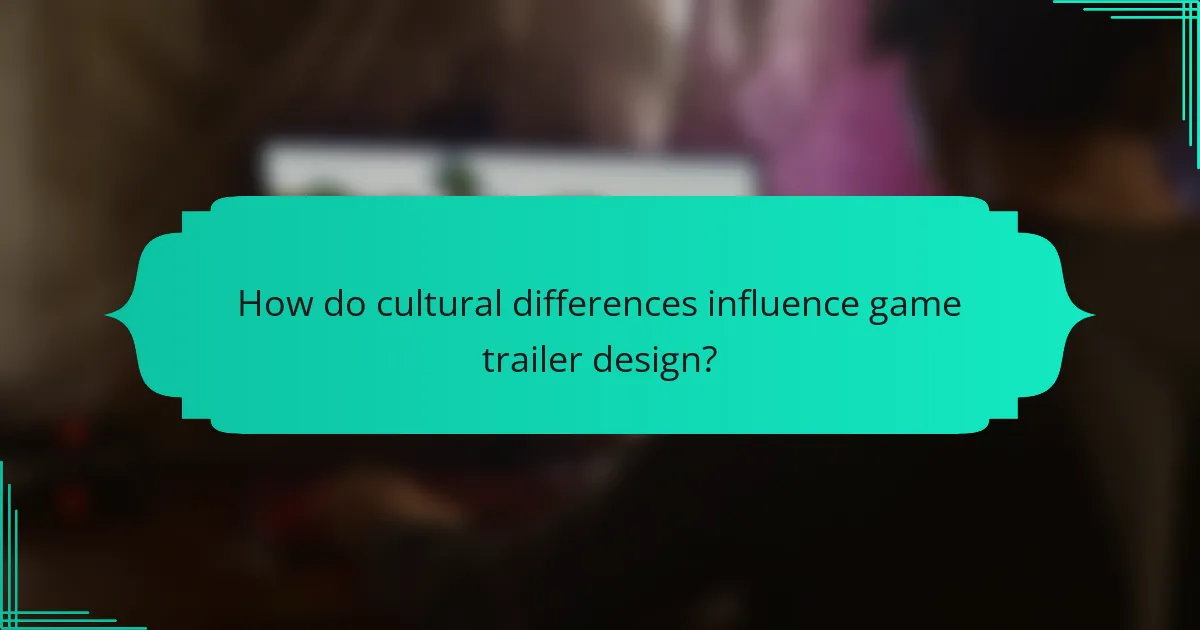Creating compelling game trailers is crucial for capturing audience interest and driving engagement. This article explores key elements like captivating visuals, effective storytelling, and gameplay showcases. It also highlights the importance of cultural considerations and innovative technologies in trailer design. Finally, we will discuss metrics for measuring trailer success and common pitfalls to avoid.

What are the key elements of an effective game trailer?
An effective game trailer includes captivating visuals, strong narrative elements, and a clear representation of gameplay. Key elements involve showcasing unique features, establishing tone, and engaging the target audience.
Visuals should be high quality and reflect the game’s art style. Narrative elements must create intrigue and convey the story without revealing too much. Highlighting gameplay mechanics and unique attributes enhances viewer interest.
Incorporating music and sound effects can evoke emotions and set the atmosphere. A well-structured trailer maintains a quick pace and ends with a strong call to action, encouraging viewers to learn more or pre-order the game.
How does pacing impact viewer engagement?
Pacing significantly influences viewer engagement in game trailers by controlling emotional intensity and narrative flow. Effective pacing maintains audience interest, guiding them through key moments without losing attention. Rapid cuts can create excitement, while slower pacing allows for deeper emotional connections. A well-paced trailer balances these elements, enhancing overall viewer retention and response.
Which visual styles resonate with different gaming audiences?
Different gaming audiences respond to various visual styles in game trailers. Action-oriented gamers prefer fast-paced, dynamic visuals that emphasize excitement. Story-driven players resonate with cinematic, narrative-focused trailers showcasing character development. Casual gamers appreciate colorful, whimsical graphics that convey fun and accessibility. Competitive players are drawn to sleek, polished aesthetics that highlight skill and strategy. Unique visual elements, like distinctive art styles or innovative animations, can also attract niche audiences.
What role does sound design play in trailer effectiveness?
Sound design significantly enhances trailer effectiveness by creating emotional connections and setting the tone. Engaging sound effects and music can evoke excitement, tension, or nostalgia, making the visuals more impactful. High-quality audio elements contribute to a cohesive experience that resonates with the audience. As a result, well-executed sound design can elevate a game’s promotional material, increasing viewer interest and anticipation.

How can storytelling enhance game trailer appeal?
Storytelling enhances game trailer appeal by creating emotional connections and engaging narratives. It captivates audiences, making them invested in the game’s world and characters. Effective storytelling can highlight key themes, showcase gameplay mechanics, and evoke curiosity, ultimately driving interest and anticipation. By using compelling visuals and a coherent narrative arc, trailers can transform potential players into enthusiastic fans.
What narrative techniques are commonly used in trailers?
Game trailers commonly use techniques such as pacing, music, and visual storytelling to engage viewers. Pacing creates anticipation through quick cuts and dynamic editing. Music enhances emotional impact and sets the tone. Visual storytelling employs imagery and character reveals to convey the game’s narrative. These elements work together to create compelling promotional content that captures audience interest.
Which character arcs are most compelling in game promotions?
Compelling character arcs in game promotions often showcase transformation, conflict resolution, and emotional depth. These elements engage players and enhance the narrative experience.
Character development that illustrates a hero’s journey or a villain’s redemption can create strong emotional connections. Players resonate with characters facing challenges, leading to a more immersive gameplay experience.
Unique attributes, such as unexpected twists in character motivations, can elevate a trailer’s impact. These surprises keep the audience intrigued and eager to explore the game’s story further.
Additionally, rare attributes like nuanced relationships between characters can add layers to the narrative. This complexity enriches the promotional material, making it more memorable and engaging.

What are the best practices for showcasing gameplay in trailers?
To effectively showcase gameplay in trailers, focus on clear visuals, engaging storytelling, and highlighting core mechanics. Use dynamic editing to maintain viewer interest and ensure audio complements the visuals.
Incorporate the following best practices:
1. Start with a hook to grab attention immediately.
2. Showcase diverse gameplay elements to provide a comprehensive view.
3. Maintain a consistent tone that aligns with the game’s theme.
4. Keep the trailer concise, ideally under two minutes, to retain viewer engagement.
5. Use subtitles or captions to enhance accessibility and understanding.
6. End with a strong call to action, encouraging viewers to learn more or pre-order.
How can developers balance cinematic and gameplay footage?
Developers can balance cinematic and gameplay footage by integrating both elements strategically. Cinematic sequences enhance storytelling, while gameplay footage showcases actual mechanics. A seamless blend allows viewers to appreciate narrative depth and gameplay experience.
To achieve this balance, consider these steps:
1. Identify key moments in gameplay that align with the story.
2. Use cinematic techniques to enhance these gameplay moments.
3. Maintain a consistent tone between gameplay and cinematic footage.
4. Test audience reactions to refine the balance.
This approach ensures trailers are engaging and informative, appealing to both narrative and gameplay enthusiasts.
What are common pitfalls to avoid when featuring gameplay?
Common pitfalls to avoid when featuring gameplay include overcomplicating visuals, neglecting clarity, misrepresenting game mechanics, and failing to engage the target audience.
Overcomplicating visuals can distract viewers from the core gameplay experience, leading to confusion. Neglecting clarity results in trailers that fail to convey essential game elements. Misrepresenting game mechanics creates false expectations, which can harm player trust. Lastly, failing to engage the target audience can lead to trailers that do not resonate, reducing potential interest in the game.

How do cultural differences influence game trailer design?
Cultural differences significantly influence game trailer design by shaping visual storytelling, themes, and audience engagement. Designers must consider cultural preferences to resonate with diverse audiences. For example, humor varies across cultures; what is funny in one may not be in another. Additionally, color symbolism differs; red can signify luck in some cultures but danger in others. Understanding these nuances ensures trailers effectively communicate the game’s essence and appeal to target demographics.
What regional preferences exist in trailer content and style?
Regional preferences in trailer content and style vary significantly based on cultural nuances and audience expectations. For example, North American trailers often emphasize fast-paced action and dramatic storytelling, while European trailers may focus more on character development and thematic depth. Asian markets, particularly in Japan, frequently utilize unique visual aesthetics and innovative editing techniques. Additionally, localizing content to resonate with regional humor and societal values enhances viewer engagement. Understanding these preferences is crucial for creating compelling visuals that effectively promote games across diverse markets.
How can localization impact the effectiveness of a trailer?
Localization significantly enhances the effectiveness of a trailer by making it culturally relevant. Tailoring content to local languages, customs, and preferences fosters greater audience engagement. For instance, localized trailers can showcase region-specific gameplay elements or character traits, appealing directly to local gamers. This approach not only increases relatability but also boosts conversion rates, as audiences are more likely to connect with content that reflects their cultural context.

What innovative technologies are shaping the future of game trailers?
Innovative technologies shaping the future of game trailers include real-time rendering, virtual reality, and AI-generated content. These advancements enhance visual quality and engagement, allowing for immersive experiences. Real-time rendering enables trailers to showcase gameplay dynamically, while virtual reality offers viewers an interactive preview. AI-generated content can personalize trailers based on user preferences, creating unique promotional material.
How is virtual reality being integrated into promotional content?
Virtual reality is transforming promotional content by enhancing game trailers with immersive experiences. This technology allows viewers to engage with the game environment, creating a deeper connection. For instance, VR can showcase gameplay mechanics in a 360-degree format, increasing viewer interest and excitement. As a result, game developers can effectively communicate their unique selling points, ultimately boosting engagement and potential sales.
What role does augmented reality play in engaging audiences?
Augmented reality enhances audience engagement by creating immersive experiences in game trailers. It allows viewers to interact with game elements, fostering a deeper connection. This technology can showcase unique gameplay features, driving excitement and anticipation. As a result, game trailers utilizing augmented reality can significantly increase viewer retention and shareability.

Which metrics are essential for measuring trailer success?
Engagement metrics are essential for measuring trailer success. Key metrics include views, shares, watch time, click-through rate, and audience retention. These metrics provide insights into viewer interest and the effectiveness of the trailer in promoting the game.
| Metric | Description | Value Example |
|————————-|———————————————————–|—————————|
| Views | Total number of times the trailer has been watched | 1 million |
| Shares | Number of times the trailer has been shared on social media | 50,000 |
| Watch Time | Total minutes viewers spent watching the trailer | 2 million minutes |
| Click-Through Rate | Percentage of viewers who clicked on the game link | 5% |
| Audience Retention | Percentage of viewers who watched the entire trailer | 70% |
How can social media engagement inform trailer performance?
Social media engagement can significantly indicate trailer performance by reflecting audience interest and potential reach. High engagement rates, such as likes and shares, often correlate with increased view counts and positive reception. Metrics like comments and shares provide insight into audience sentiment, which can guide marketing strategies. Analyzing these interactions helps identify effective visuals and messaging that resonate with viewers.
What analytics tools are most effective for tracking viewer behavior?
Analytics tools that effectively track viewer behavior for game trailers include Google Analytics, Mixpanel, Hotjar, and Crazy Egg. These tools provide insights on viewer engagement, retention rates, and interaction patterns. Google Analytics offers comprehensive tracking of user demographics and behaviors, while Mixpanel excels in event tracking. Hotjar provides heatmaps for visualizing user interactions, and Crazy Egg offers A/B testing features to optimize trailer performance. Each tool contributes unique attributes that enhance understanding of viewer preferences and behaviors.

What common mistakes should creators avoid in game trailers?
Creators should avoid common mistakes that diminish the impact of game trailers. Key pitfalls include focusing too much on story rather than gameplay, neglecting pacing, using poor-quality visuals, and failing to highlight unique features. Each of these mistakes can lead to trailers that fail to engage potential players effectively.
Overemphasizing narrative can make trailers feel slow and unexciting. Instead, showcasing gameplay mechanics captures viewer interest. Pacing is crucial; a trailer that drags can lose attention quickly. High-quality visuals are essential, as poor graphics can create a negative first impression. Lastly, not showcasing unique attributes of the game can leave potential players unaware of what sets it apart from competitors.
How can overhyping a game negatively affect trailer reception?
Overhyping a game can lead to negative trailer reception by creating unrealistic expectations. When trailers promise extraordinary features or experiences that the final product does not deliver, disappointment ensues. This dissonance can damage the game’s reputation and diminish player trust. Additionally, excessive hype can overshadow genuine qualities of the game, leading to a skewed perception among potential players. Ultimately, maintaining a balanced promotional approach is crucial for aligning expectations with reality.
What are the consequences of neglecting target audience preferences?
Neglecting target audience preferences can lead to ineffective game trailers that fail to engage viewers. This results in reduced interest, lower conversion rates, and potential damage to brand reputation. Understanding audience demographics, interests, and viewing habits is crucial for creating compelling visuals that resonate. A well-tailored trailer enhances viewer connection, drives engagement, and maximizes promotional impact.
What expert tips can help optimize game trailer production?
To optimize game trailer production, focus on clear storytelling, high-quality visuals, and engaging sound design. Start with a strong hook that captures attention within the first few seconds. Develop a narrative that highlights key gameplay elements and emotional connections. Utilize professional editing techniques to enhance pacing and visual appeal. Test trailers with target audiences to gather feedback and refine content.
